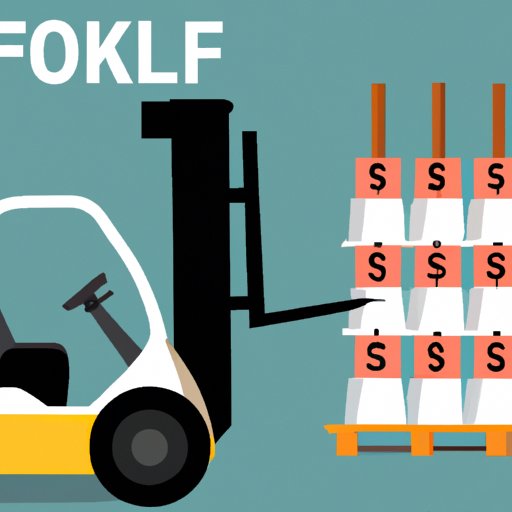Introduction
A forklift is a type of industrial vehicle designed to move heavy materials, typically in warehouses and factories. It is an essential piece of equipment for many businesses, from small retail stores to large manufacturing facilities. The cost of a forklift depends on several factors, including whether you are buying new or used, renting or leasing, and the size and features of the forklift itself.
Cost Comparison of New vs Used Forklifts
When it comes to buying a forklift, there are two main options: new or used. The average cost of a new forklift ranges from $15,000 to $25,000, depending on the size and features. Used forklifts generally cost between $5,000 and $15,000, depending on their condition and age. Buying a new forklift offers the benefit of having a reliable machine with a full warranty, while buying a used forklift is usually more cost-effective.

How To Calculate The Total Cost of a Forklift
When calculating the total cost of a forklift, there are several factors to consider. First, you should factor in the purchase price of the machine itself. Additionally, you will need to account for any additional costs, such as delivery and setup, taxes, and insurance. You may also need to factor in the cost of any accessories or attachments that you may need.
How Much Does a Forklift Rental Cost?
Renting a forklift is often the most cost-effective option for short-term projects or for businesses that don’t have the budget to purchase a new or used machine. The cost of renting a forklift varies depending on the size and features of the forklift, the length of the rental period, and the company from which you are renting. Generally speaking, renting a forklift for one day will cost around $100 to $250, while a longer term rental could cost up to $1000 per month.

Factors that Affect the Cost of a Forklift
The cost of a forklift is affected by several factors, including size and capacity, features, and brand. For example, larger and heavier capacity forklifts tend to be more expensive than smaller models. Additionally, forklifts with advanced features such as tilt steering, automatic transmission, and hydraulic lift systems will cost more than basic models. Finally, the brand of the forklift can also play a role in determining the cost, as some brands are more expensive than others.
What Are The Different Types Of Forklifts and Their Costs?
There are several different types of forklifts available, each with its own advantages and disadvantages. The most common types of forklifts include electric, gas, and diesel. Electric forklifts are the most affordable option, costing between $20,000 and $30,000 for a new model. Gas and diesel forklifts are more expensive, ranging from $25,000 to $50,000 for a new model. Additionally, there are specialized types of forklifts, such as rough terrain, container handlers, and reach trucks, which can cost even more.

Pros and Cons of Buying vs Leasing a Forklift
Buying a forklift is the best option for businesses that plan to use the machine for a long period of time and need the ability to customize it. However, buying a forklift requires a significant upfront investment, so it may not be the best choice for businesses with limited budgets. Leasing a forklift is a good option for businesses that need a machine for a short period of time or want to avoid a large upfront cost. However, leasing can be more expensive in the long run, and you won’t own the machine at the end of the lease.
What Is Included in The Price of a Forklift?
When purchasing a forklift, the price typically includes the cost of the machine itself as well as any standard accessories. Standard accessories may include forks, stabilizers, and hoses. Depending on the manufacturer, you may also be able to purchase optional accessories, such as side shift or rotator attachments, for an additional cost.
Conclusion
In conclusion, the cost of a forklift depends on several factors, including whether you are buying new or used, renting or leasing, and the size and features of the machine. Additionally, the cost of a forklift can vary depending on the type of machine and the features and accessories included. When making your decision, it’s important to consider all of these factors and determine what makes the most sense for your business.
(Note: Is this article not meeting your expectations? Do you have knowledge or insights to share? Unlock new opportunities and expand your reach by joining our authors team. Click Registration to join us and share your expertise with our readers.)
